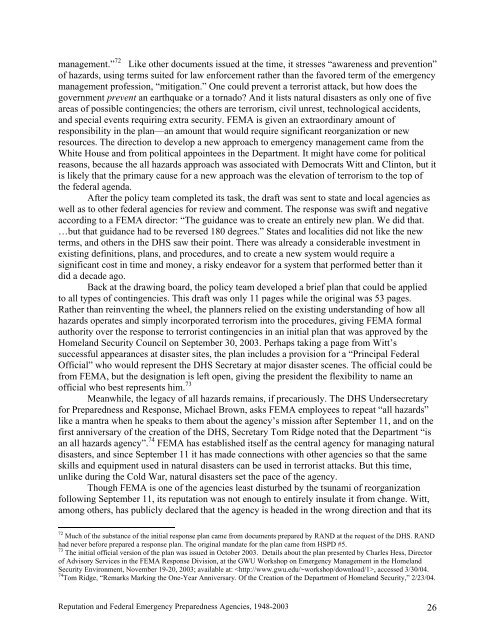Reputation and Federal Emergency Preparedness Agencies, 1948
Reputation and Federal Emergency Preparedness Agencies, 1948
Reputation and Federal Emergency Preparedness Agencies, 1948
You also want an ePaper? Increase the reach of your titles
YUMPU automatically turns print PDFs into web optimized ePapers that Google loves.
management.” 72 Like other documents issued at the time, it stresses “awareness <strong>and</strong> prevention”<br />
of hazards, using terms suited for law enforcement rather than the favored term of the emergency<br />
management profession, “mitigation.” One could prevent a terrorist attack, but how does the<br />
government prevent an earthquake or a tornado? And it lists natural disasters as only one of five<br />
areas of possible contingencies; the others are terrorism, civil unrest, technological accidents,<br />
<strong>and</strong> special events requiring extra security. FEMA is given an extraordinary amount of<br />
responsibility in the plan—an amount that would require significant reorganization or new<br />
resources. The direction to develop a new approach to emergency management came from the<br />
White House <strong>and</strong> from political appointees in the Department. It might have come for political<br />
reasons, because the all hazards approach was associated with Democrats Witt <strong>and</strong> Clinton, but it<br />
is likely that the primary cause for a new approach was the elevation of terrorism to the top of<br />
the federal agenda.<br />
After the policy team completed its task, the draft was sent to state <strong>and</strong> local agencies as<br />
well as to other federal agencies for review <strong>and</strong> comment. The response was swift <strong>and</strong> negative<br />
according to a FEMA director: “The guidance was to create an entirely new plan. We did that.<br />
…but that guidance had to be reversed 180 degrees.” States <strong>and</strong> localities did not like the new<br />
terms, <strong>and</strong> others in the DHS saw their point. There was already a considerable investment in<br />
existing definitions, plans, <strong>and</strong> procedures, <strong>and</strong> to create a new system would require a<br />
significant cost in time <strong>and</strong> money, a risky endeavor for a system that performed better than it<br />
did a decade ago.<br />
Back at the drawing board, the policy team developed a brief plan that could be applied<br />
to all types of contingencies. This draft was only 11 pages while the original was 53 pages.<br />
Rather than reinventing the wheel, the planners relied on the existing underst<strong>and</strong>ing of how all<br />
hazards operates <strong>and</strong> simply incorporated terrorism into the procedures, giving FEMA formal<br />
authority over the response to terrorist contingencies in an initial plan that was approved by the<br />
Homel<strong>and</strong> Security Council on September 30, 2003. Perhaps taking a page from Witt’s<br />
successful appearances at disaster sites, the plan includes a provision for a “Principal <strong>Federal</strong><br />
Official” who would represent the DHS Secretary at major disaster scenes. The official could be<br />
from FEMA, but the designation is left open, giving the president the flexibility to name an<br />
official who best represents him. 73<br />
Meanwhile, the legacy of all hazards remains, if precariously. The DHS Undersecretary<br />
for <strong>Preparedness</strong> <strong>and</strong> Response, Michael Brown, asks FEMA employees to repeat “all hazards”<br />
like a mantra when he speaks to them about the agency’s mission after September 11, <strong>and</strong> on the<br />
first anniversary of the creation of the DHS, Secretary Tom Ridge noted that the Department “is<br />
an all hazards agency”. 74 FEMA has established itself as the central agency for managing natural<br />
disasters, <strong>and</strong> since September 11 it has made connections with other agencies so that the same<br />
skills <strong>and</strong> equipment used in natural disasters can be used in terrorist attacks. But this time,<br />
unlike during the Cold War, natural disasters set the pace of the agency.<br />
Though FEMA is one of the agencies least disturbed by the tsunami of reorganization<br />
following September 11, its reputation was not enough to entirely insulate it from change. Witt,<br />
among others, has publicly declared that the agency is headed in the wrong direction <strong>and</strong> that its<br />
72 Much of the substance of the initial response plan came from documents prepared by RAND at the request of the DHS. RAND<br />
had never before prepared a response plan. The original m<strong>and</strong>ate for the plan came from HSPD #5.<br />
73 The initial official version of the plan was issued in October 2003. Details about the plan presented by Charles Hess, Director<br />
of Advisory Services in the FEMA Response Division, at the GWU Workshop on <strong>Emergency</strong> Management in the Homel<strong>and</strong><br />
Security Environment, November 19-20, 2003; available at: , accessed 3/30/04.<br />
74 Tom Ridge, “Remarks Marking the One-Year Anniversary. Of the Creation of the Department of Homel<strong>and</strong> Security,” 2/23/04.<br />
<strong>Reputation</strong> <strong>and</strong> <strong>Federal</strong> <strong>Emergency</strong> <strong>Preparedness</strong> <strong>Agencies</strong>, <strong>1948</strong>-2003 26

















